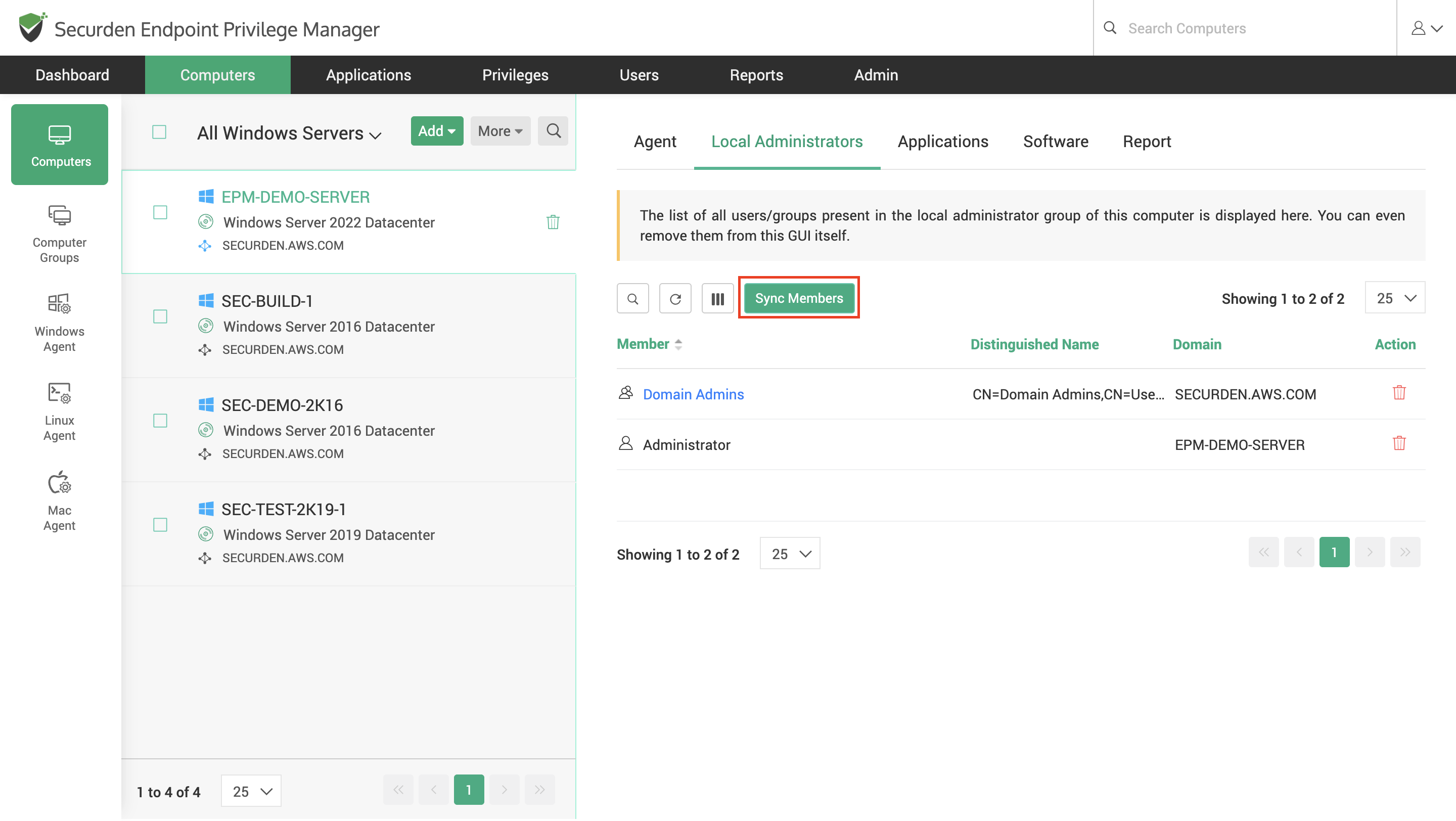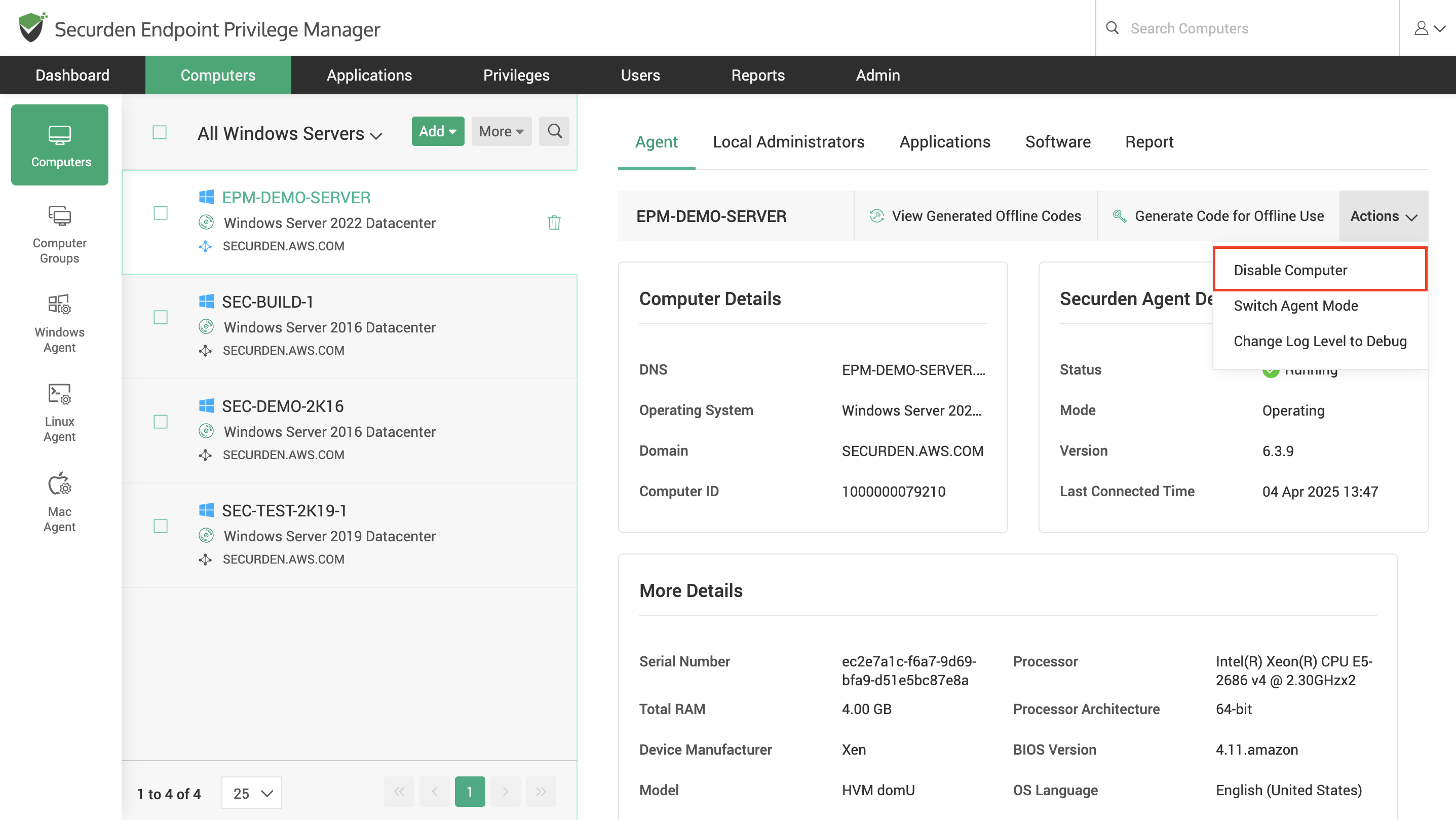How to Manage Computers in Securden EPM?¶
Once the required computers are onboarded, you can manage them from the computers tab. This interface acts as the hub for all device-related provisions/activities.
The Computer tab displays information about the computers on which the agent has been deployed across multiple tabs named Agent, User Accounts/Local Administrators, Applications, Software, and Report.
1) The Agent tab provides details about the hardware and software running on the computer. You can disable computers, modify the agent mode and log levels from here.
2) The User Accounts tab displays all the local user accounts on the endpoint. If the computer is domain joined, then all the local administrators alone will be displayed.
3) The Applications tab displays all the applications discovered by the agents on this computer. The applications that can be used for policy creation are listed here.
4) The Software tab displays all the software discovered by the agent on a particular computer. This acts as an inventory of all software discovered in the computer.
5) The Report section provides insights on all the application permissions granted through policies in Securden, list of system process run, and software installed on the particular computer.
How to Fetch the Local User Accounts on a Non-domain Computer?¶
Once the Securden privilege management agent is deployed on a non-domain endpoint, the local user accounts are automatically fetched by the agent.
The accounts that were fetched by the agent can be found by navigating to the Computers tab. Here, select the required non-domain computer and go to the Local Users tab. Here the list of local user accounts can be found.
How to Synchronize the list of Local Administrators on a Computers?¶
Securden fetches the list of local administrators on an endpoint from the Active Directory. You can synchronize the list of local admin accounts using the agent.
Navigate to the Computers section and select a domain computer. Go to the Local Administrator tab and click on Sync Members.
You can also remove the user from the local administrator group by deleting the user from this list of local administrators.
Note
This option is only available for domain computers that have the Securden Agent installed on the device.
How to Create an Application Control Policy from the Computers tab?¶
You can create application control policies for specific computers right from the computers tab.
1) Go to the Computers tab and navigate to Applications on the right-hand side.
2) Here, all the applications that can be added to a policy are listed.
3) You need to select the applications you want a policy for.
4) Click on Create Control Policy.
5) If you want to add these applications to an existing control policy, click on Add to Existing Policies.
If you are creating a new policy,
1) You need to specify the control policy name, and description.
2) Search and select the required users and groups with whom the policy must be associated. The users and groups added to Securden, local users discovered by the agent, and the users and groups fetched from Azure AD can be found in their respective field.
If you are adding the applications to an existing policy, you can simply search and select the policy from the drop-down menu and save the changes.
Note
Built-in policies will not be displayed since the applications associated with these policies cannot be modified.
How to Disable Computers from the Securden EPM Interface?¶
Note
Disabled computers will not be accounted for licensing purposes.
You can disable computers by clicking on the required computer in the Computers tab and navigating to Actions >> Disable Computer.
You can disable multiple computers at a time by selecting all the required computers from the Computers tab and going to More >> Disable Computers.
Note
When a certain computer has been found to be removed from the domain computer groups at the time of domain group synchronization, the specific computer will become disabled in Securden.
Frequently Asked Questions¶
1) How to Find the List of Applications that can be Run with Elevated Permissions on a Specific Computer in EPM?
The list of applications that can be elevated using the agent on each computer is available in the Report section in the Computers tab.
2) How to Find the List of Blocklisted Application on a Specific Computer in EPM?
The list of applications that are blocklisted on a specific computer can be found by following the steps below.
-
Go to the Computers tab and click on the required computer.
-
Navigate to the Reports section. Scroll down to find the list of apps that are blocklisted on the computer.
3) How to find the list of software installed on a specific computer?
To find the list of software installed on a specific computer, follow the steps below.
-
Navigate to the Computers section and click on the required computer.
-
Go to the Software tab (or) go to the Reports tab and scroll down to find the list of all software installed on the computer.
4) How to find the list of all system processes that run on a specific computer?
To find the list of system processes that run on a specific computer, follow the steps below.
-
Go to the Computers tab and find the required computer.
-
Once you have clicked on the required computer, navigate to the Reports section and scroll down to find the list of system processes that run on the computer.



